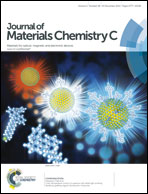Above-room-temperature molecular ferroelectric and fast switchable dielectric of diisopropylammonium perchlorate†
Abstract
The transition temperatures of molecular ferroelectrics are usually lower than those of inorganic ferroelectrics due to weaker electron–electron and electron–phonon interactions in molecular ferroelectrics. Therefore, above-room-temperature molecular ferroelectrics are very rare which hinders their application in modern electronic fields. Here we report a new kind of above-room-temperature molecular ferroelectric, diisopropylammonium perchlorate (DIPAP), which combines fast switchable molecular dielectrics. The ferroelectric to paraelectric phase transition occurs at about 338 K in the heating process, which was confirmed by structure analysis (from space group of P1 to P21/c), differential scanning calorimetry (DSC), dynamic mechanical analysis (DMA), dielectric permittivity, pyroelectric as well as Raman spectra. The spontaneous polarization measured from pyroelectric current and ferroelectric hysteresis loop is about 0.1 μC cm−2, while the calculated value by first principles is as high as 20 μC cm−2. This large theoretical spontaneous polarization value can be achieved through designing and modulating a molecular structure to a fully polarized one.


 Please wait while we load your content...
Please wait while we load your content...